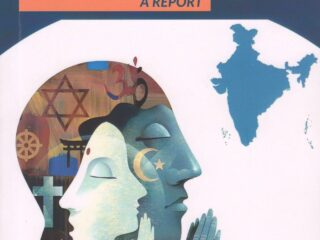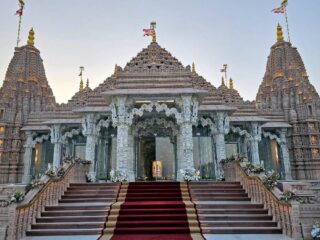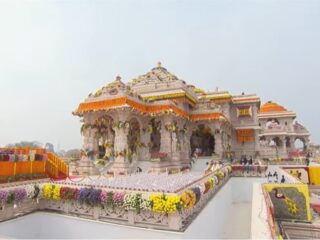Irfan Engineer
(Secular Perspective September 16-30, 2013)
Year after year there are major riots in the country. Yet the UPA is sitting over Communal and targeted Violence (Access to Justice and Reparations) Bill! How many lives must be lost before the UPA Govt. wakes up to the reality that special situations require special laws? There have been more than 40,000 casualties since the year 1950 in Hindu-Muslim riots alone. Yet, hardly any foot soldier has been punished and the conspirators, abettors and orchestrators of the riots climb up the political ladder and become ministers and chief ministers instead of finding them behind bars. When security of all Indians is threatened through bomb blasts, the response of the state is to immediately come with special laws like TADA, POTA and UAPA. Security forces are given free hand to target innocent members of minority communities with impunity under protection of laws like Disturbed Areas Act and AFSPA. When women are sexually assaulted, the response of the state is to issue an ordinance (and rightly so), which if implemented in right spirit, could ensure that offenders would be brought to justice. However, when security of minorities is under threat, they are advised to behave better and forget the incident in the interest of “national integration” and “peace”. Poor relief for survivors of riots, negligible compensation to a few survivors, reluctance to bring riot entrepreneurs to justice, and worsening condition of riot survivors encourages the riot entrepreneurs to orchestrate, plan and execute even larger and more vicious riots. Riot entrepreneurs are acquiring more and more capability to inflict larger casualty in shorter duration, whether or not they are in power. Lack of will to legislate a special law to ensure access to justice and right to reparations for riot survivors is viewed by the riot entrepreneurs as an enabling environment to orchestrate riots and a politically desirable goal.
Last year, (in the year 2012) the country witnessed major riots in Bodo areas of Assam state, UP witnessed 9 riots – Kosi Kalan and Pratapgarh (both in Mathura), two in Gaziabad, Sitapur, Bareilly, two in Faizabad and Bijnor. Maharashtra witnessed communal riots in Pachora, Buldhana, Raver (Jalgaon) and Akot. In Andhra Pradesh, communal riots occurred in Sangareddy and Hyderabad. In Gujarat, communal clashes broke out in Vadodra and Damnagar (Amreli). This year too had witnessed several riots in Dhule (Maharashtra), Nawada (Bihar) Kishtwar (Jammu), UP, and other states. Given the election year, the riots are becoming more frequent and larger in scale with the Kishtwar and Muzaffarnagar acquiring national attention. Every election, a few members of minority communities must be killed to ensure a few more seats for communal parties. On the one hand Narendra Modi is pretending to confine his election campaign supposedly on the issue of development and good governance, while the other fraternal organisations of the Sangh Parivar like VHP are busy looking for issues to polarize the electorate and to politically mobilize the diverse Hindu communities and attempt to convert them into a political community and vote bank. The 84 kosi parikrama during election time when there was no religious tradition by the VHP is a case in point. Sangh Parivar has used communal violence as a policy instrument to widen its base and strengthen its organisation.
The Muzaffarnagar Riots
According to the Times of India (TOI) dated 17/9/13, on August 27, there was a minor scuffle in Kawaal village of Muzaffarnagar between Shahnawaz and Gaurav over crossing of motorbike and bicycle, when Shahnawaz allegedly slapped Gaurav. Gaurav mobilized his accomplices and killed Shahnawaz. People witnessing the incident caught hold of Sachin and Gaurav among those involved in killing Shahnawaz and they were in turn beaten to death. The version of Jats as reported in the TOI was that locals gathered during the incident and in the melee some Muslim by mistake stabbed Shahnawaz. The Jat version does not seem very credible, but it is for the police to investigate, if at all they investigate impartially and thoroughly without any fear or favour.
A fake video of some other incident which the police say was recorded two years ago was circulated through social networking sites and mobile phones purporting it to be video of the incident of killing Gaurav and Sachin. The fake video allegedly circulated by BJP MLAs seemed to have evoked a lot of revulsion and consequent urge to take revenge. Interestingly, Jats were not first to react to the incident. It was the Sainis who traditionally are supporters of BJP, took lead in reacting to the killing of Gaurav and Sachin and mobilised the Jats. A BSP leader and other politicians mobilized Muslims for a meeting on 30th August. Four BJP MLAs organised Jat Mahapanchayat. The Mahapanchayat was attended by thousands of Jats armed with guns, swords and other lethal weapons in spite of ban on assembly. How the police allowed them to assemble with arms in spite of orders prohibiting assembly is for the police to explain. In all three Mahapanchayats were organised and inciting speeches were given. Allegedly provocative slogans were in the air during the Jat Mahapanchayats and one of them reportedly were “Musalman ke do hi sthan – Pakistan ya kabristan”. The rest is history as they say. Several houses burnt, more than 40,000 in relief camps, 43 killed according to affidavit filed in the Supreme Court by the UP Govt. One TOI report dated 15-9-13 quoted doctors conducting post mortem on 53 bodies were shocked by the brutality with which the murders were carried out, including mutation of female genitals. The web edition of the Daily Bhaskar (Anwar & Khan, 2013) reports “Scores of women, including minor girls, were raped, gang-raped and sexually assaulted in Lisarh, Lank, Bahawadi, Hasanpur, Mohammadpur, Baghpat and many other small villages of Muzaffarnagar, Shamli and Panipat districts of Uttar Pradesh. The rape took place when the people were leaving their villages to save their lives and honour, say victims.” The police, as usual, were mute spectators while all the violence and burning was happening, even as the survivors were desperately crying for help. This is criminal negligence on the part of the police and administration in allowing the Jat Mahapanchayats and inciting speeches. The BJP leaders used the three murders over an inconsequential issue to incite communal passions and violence for electoral gains and the Samajwadi Party seems to have played along to gain electorally too.
Concerns and issues
The rioters usually act on a doctrine of collective culpability of the community in any wrongdoing by any member of the “other” community. They have borrowed this doctrine of primitive times when any violation of taboo by any member of the rival tribe could be attributed to every member of that tribe in the nature of collective guilt and could be avenged by collectively punishing entire tribe or any member of the tribe. It is a primitive and barbarous way of thinking to impute guilt to someone for the action of another. Collectives do not have moral faults, since they don’t make moral choices and cannot be ascribed moral responsibility. Thus every member of Muslim community is culpable for the perceived offence allegedly committed by any of them, even in the distant past – namely demolition of Hindu temples. A collective punishment in the form of communal riots is handed down in order to deepen and polarize communal identities within members of both communities. With the polarization, they would be permanently in conflict with each other and larger numbers of the majority community could be mobilized more easily in this “war”. When will communal forces overcome this primitive instinct?
Collective Punishments, cultural nationalism and authoritarian state
Collective punishments are calculatedly inflicted by communal forces to obliterate the multiple identities within every individual that makes her unique. For example, this author is a Gujarati ashraf Muslim born in and domicile of Maharashtra, a male, Indian, advocate, influenced by liberal left ideology, loving books etc. etc. Individuals make sense of their world through these identities. They sometimes consciously transcend some of these primordial and acquired identities. It is on this edifice of individual having multiple identities that the concept of citizenship is based. Citizens are invested with liberties and rights that enable them to live these multiple identities and still be treated equally disregarding their identities and ideologies that they chose to follow, so long as they are not in conflict with laws of the land. The communal forces target particular community to make given primordial identity salient in the individual marginalizing others. For example, if Muslims are targeted only because of their religion, this author’s all other identities (like Gujarati, domicile of Maharashtra, male, ashraf, following liberal left ideology and book loving) become inconsequential except the fact that he is Muslim, which otherwise may not be salient in him. However, large scale violence does not only obliterate multiple identities within the targeted community. It marginalizes multiple identities even within the members of the community on whose behalf the violence is perpetrated, and brings to salience mirror identity within them for fear of violent reprisals.
By targeting Muslim community, communal forces want to make Hindu identity salient within members of their community, and in the process, marginalizing say for example caste, regional, ethnic, gender, professional, neighbourhood based and hobby based identities. Through this process, the religious Hindu is converted into a political Hindu requiring authoritarian cultural state privileging certain religion and suppressing others. Thus Jats and Muslims, which communities shared the regional culture, dialect, traditions, value systems, now fear each other. It is because of these shared culture and traditions that Charan Singh could politically mobilise the two communities together to vote for his party RLD. The Muzaffarnagar riots have divided the two communities Jat Muslims and Jat Hindus deepening communal identities within them and marginalizing their shared regional and caste identity. The Jat Muslims will now have to live with, and become more of “Muslims” seeking communal solidarity of the Syeds and Pathans of the region and likewise Jats will have to seek communal solidarity, unity and identity with the Sainis and the Hindu upper castes. How this process plays out in future remains to be seen. However, this process leaves space only for communal forces on both sides to flourish – RSS and Sangh Parivar, including the BJP in an election year on one hand and Majlises, Jamiats and Mushawarats on the other hand, who become arbiters of Muslim votes. The Hindu Jats will now be subjected to communal propaganda like “all terrorists are Muslims”, that “Muslims are pro-Pakistanis and anti-nationals” etc.
Spread of communalism in rural areas
Even if theatre of communal riots had already shifted to rural areas from urban areas, for example in Bhagalpur, Nellie, Gujarat and BTAD, they were more of extension of urban based conflict. However, the theatre of violence this time in Muzaffarnagar, Shamli and Meerut is predominantly rural. The large scale displacement cause by the violence in Muzaffarnagar is unprecedented for UP with survivors stating they will never be able to return to their villages again. This is a dangerous and worrisome trend. The brutality reflects the revulsion caused by the circulation of fake video and the likelihood of hatred that will be premised on the revulsion on long term basis unless there is effective intervention strategy from secular and democratic forces to reconcile the communities.
Women’s bodies continue to be the battleground on which communal violence played out. The Jat Mahapanchayats emerge as strengthened and hegemonic force. What does this mean for Jat women, already facing several Talibani restrictions like the one on possession of mobile phones, restrictions on their dresses, choice of male friends and the timings and localities in which the restrictions would operate. The male-female ratio is highly skewed and women excluded from inheritance in practice. Women’s organizations were struggling for equality and inclusion. Strengthening of Jat Mahapanchayats and Majlises, Jamiats and Mushawarats would push the achievement of the struggle of these women’s organisations how many years behind is to be seen. There are already reports of women being pulled out of educational institutions, particularly Muslim girls against their desires due to communalization and consequent security issues for women. The riots were according to one report, started with sexual harassment of a woman, though the TOI report dated 17-9-13 denies any such sexual harassment.
How far the caste based voting pattern is affected and how far Hindu votes consolidate across all castes in UP and outside the state is another issue of concern. For communal polarization would help poll campaigners for Modi. In this communally charged atmosphere, the voters suspend their judgments even more and prone be misled by Modi’s campaign managers’ exaggerated and even false claims. Better performance in UP for BJP is crucial for Modi’s PM ambitions. BJP is the biggest beneficiary of the Muzaffarnagar riots making itself popular among the Jats. BJP is incessantly attacking Samajwadi Party, hoping to displace BSP as the principal opposition party. However, that chance seems too too remote.
For the secular and democratic forces, the main concern is ensuring organisation of relief camps, that compensation reaches the victims, reconciliation and rehabilitation and peace with justice. Secular democratic forces have learnt to force the Govt. to bring the guilty to justice. Exposing the design of communal forces and making people of India accept individual liberties, equality and social justice for all citizens of India irrespective of their religion is urgent priority. To ensure justice, we will have to demand with renewed vigour legislation on Communal and Targeted Violence (Access to Justice and Reparations) Bill be enacted immediately.
————————————————–
Centre for Study of Society and Secularism
Mumbai.




